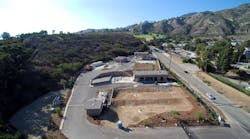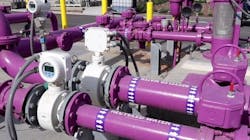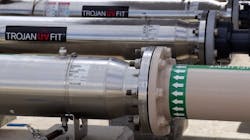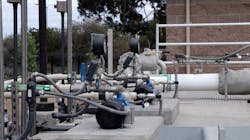About the author:
Sara Myers is associate editor for WWD. Myers can be reached at [email protected].
In sunny Malibu, Calif., the Civic Center Water Treatment Facility provides a new level of sustainable water management by using efficient and safe reuse of flows rather than using drinking water for landscape irrigation.
- Location: Malibu, California
- Size: 502,000 gpd.
- Infrastructure: Submersible pumps, collection systems, coarse screen and grit vortex, fine screens and compactors, biological reactor submersible mixers, disinfection, membranes, recycled water pump station, chemical pumps
The project brought a centralized community facility with a robust level of treatment and a recycled water system to the area. Malibu’s treated wastewater will now be available to irrigate and green some of the city’s most popular public spaces.
The plant will save up to 70 million gal of fresh water annually that would have otherwise been given up to lawns, creating an opportunity to serve more than 1,500 residents with quality drinking water. Wastewater treated by the new facility represents a responsible way to produce recycled water that will help ease the impacts of future drought cycles.
“This has probably been in the making for probably 10, 15 years for the city of Malibu,” said Rob Duboux, public works director and city engineer for the city of Malibu. “Malibu was previously an unincorporated portion of LA county and all of their properties—a wastewater system and septic system—all the properties had their own separate septic systems that they had to own and operate several years ago.”
Malibu always has been a step ahead in adopting environmentally focused programs, policies and projects that have led the state to real action with tangible benefits, Duboux said. The project supports efforts to address California’s drought by reducing the use of drinking water to irrigate public spaces and parks.
The $60 million facility was made possible through the cooperation of Civic Center property owners with assistance from the California State Water Resources Control Board. The city formed a community facilities district to fund the design, and formed an assessment district among Civic Center properties to fund the construction. The city was able to secure a $9 million grant, a 1% interest State Revolving Fund (SRF) loan of $24.6 million and a 1.7% interest SRF loan of $26.8 million that helps lower the annual assessments for each property owner.
The LA regional water control board put a memorandum on septic system use in the Malibu Civic Center area, Duboux said. It is located in the central part of the city, close to Pepperdine University. It also is where a number of commercial properties are located.
“Eventually, we came up with a solution to phase in all replacements or to eliminate all the septic systems within this civic center area, where it’s mostly commercial area,” Duboux said. “The regional board and the city entered into a memorandum of understanding, where they went and phased in the collection system and the treatment plant.”
The project was completed in three phases, Duboux said. The daily flow was 211,000 gal per day (gpd), and phase two was 350,000 gpd. Phase three was the final phase and was completed in 2018, which brough the flow to its current total of 502,000 gpd.
The facility will capture and treat up to 200,000 gal of wastewater daily and convert the water for irrigation purposes. The treatment plant uses multiple processes to produce clean, Title 22-certified recycled water, including particle filtration, centrifuges, ultra-fine filtration membranes, bio-digestion, and ultraviolet light to kill any remaining bacteria and viruses.
“It’s a membrane bioreactor system. It goes into our 100,000 gal equalization basin. From there it goes into a biological reactor that is used for the process. We have four separate trains used for that process. We then do our final screening with a membrane facility where it is treated at the last stage,” Duboux said. “After the membranes it goes over to a UV disinfection system where it kills all the remaining bacteria and viruses. Then it gets transported over to our recycled water distribution center where it gets pumped out to all the customers that are connected into wastewater and they’re able to get recycled water.”
The Challenges
The first challenge for the staff was convincing the public that the new system would provide a benefit to the community by generating recycled water for irrigation, reducing the potable water demand.
“This is going to be a good system. It’s going to be better for the environment, and better for the community in the long haul,” Duboux said. “This took a lot of stakeholder meetings with property owners and other community members to discuss the system and what the benefits will be.”
Another challenge was putting in the new collection system. Because the facility is right next to the ocean, it has a lot of groundwater issues, Duboux said. In some areas, the system is underwater.
“We didn’t want any groundwater, or saltwater from the ocean to come up through our system,” Duboux said. “Because our plant wasn’t able to treat that level of water, making sure it was constructed watertight was important. The second part was coordinating all of the connection from all the property owners into the new collection system. The collection system was put in and lateral was run up to the property line. It was the property owner’s responsibility to connect their system to the collection system.”
A deadline was put in place by the regional board to make sure all septic systems were offline by a certain date. There was a lot of coordination between the staff and the property owners to make sure the owners were aware of these deadlines. Fortunately, everyone involved met the deadline at the last minute and the property owners were able to connect to the treatment plant, Duboux said.
Air Pressure
Reverse air pressure in all of the buildings prevents odors from escaping the facility. The air that is drawn out is pushed out through a bed of mulch and wood chips, in an all-natural, chemical-free, filtration process to reduce the impact of foul smells on the surrounding community.
“Our headworks building is essentially an enclosed structure. We use blowers and fans to draw the foul air from those facilities,” Duboux said. “Our influence pump station, our headworks, our bioreactor, and solid handling facility are all connected to a blower system that takes all the foul air from these facilities and runs it through a bioreactor system.”
The foul air goes into underground pipes, which have holes in them. The air then seeps up through those holes. The pipes are embedded in approximately 3 to 4 ft of mulch material, which keeps it moist, Duboux explained.
“You don’t smell it in any of the facilities. It’s pretty remarkable,” Duboux said. “All of the headworks machinery has their individual foul air piping that draws all the air from it. This is good because right across the street from our plant we have some condo [condominium] development, and we also have a school.”
The community did not want to smell a wastewater plant, so designers made an effort to ensure the system was sustainable enough to draw those foul odors without adding any chemicals to the process. All of these features were implemented during the final phase, Duboux said.
“This plant is pretty unique to where we’re able to treat this wastewater in this small area and provide the huge benefit of recycled water to the customers for irrigation,” Duboux said. “Potable water here is kind of a commodity, and a very high commodity.”
For several years, California has been in a state of drought and using drinking water for irrigation is something everyone should approach with thoughtfulness and caution,
Duboux said.
“We’re conserving as much water as we can for essential needs,” Duboux said. “That is a really great benefit for this community, and to be able to actually have the landscaping that everyone likes to have out there and not have a huge demand on potable water, that is one of the biggest benefits I see for this treatment plant.”



